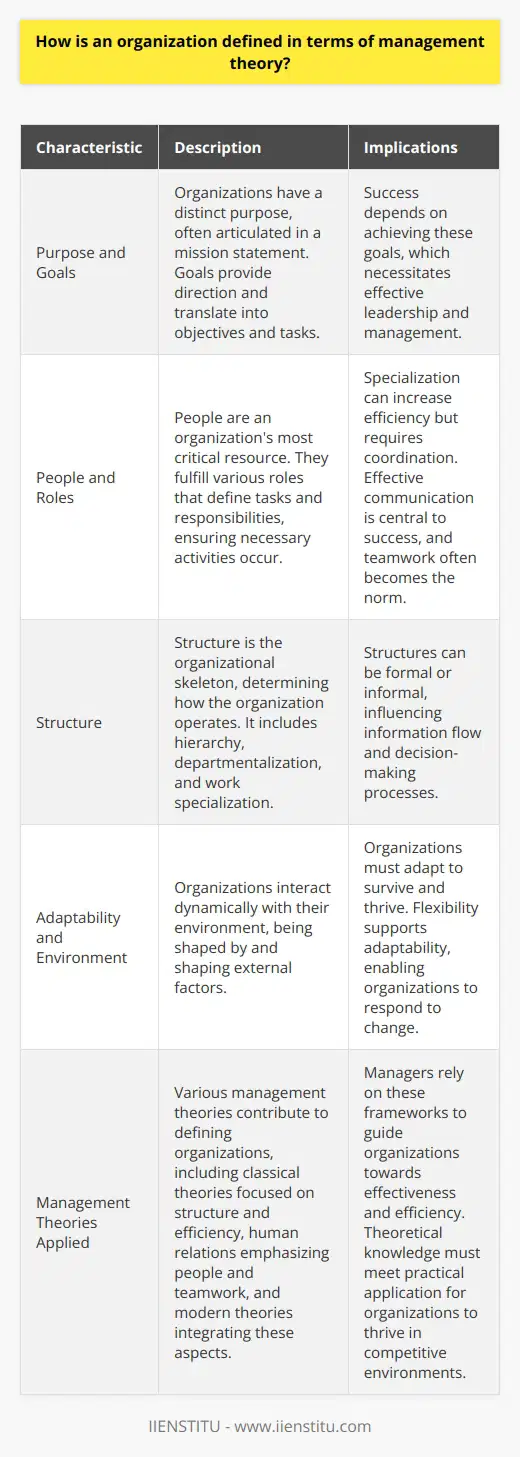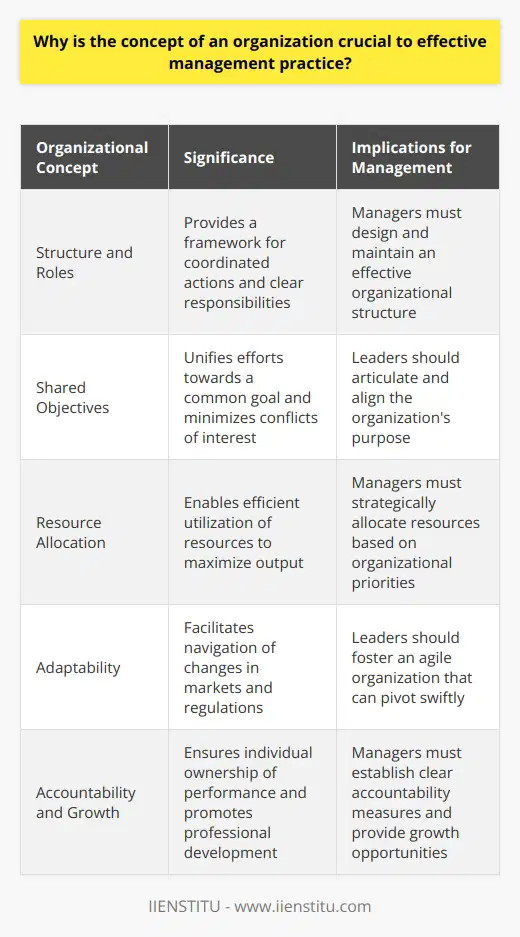
The landscape of business management is marked by an ever-evolving tapestry of concepts and principles, among which, understanding the fundamentals of an organization's structure and its management principles is paramount. Management principles serve as a compass for leaders and managers, offering direction and a framework within which decision-making and strategy formulation can take place. On the other hand, a concrete organization definition plays a pivotal role as the foundation upon which all managerial initiatives are built.
This blog post aims to dissect and explore the intricate relationship between the organizational foundation and the implementation of sound management principles. In delving into these key areas, the discourse also brings to light essential insights for those pursuing further development through avenues like mba free course or certificate courses online. In doing so, we unfold the narrative that a robust understanding of what constitutes an organization is not merely academic but crucial in enabling effective management practices.
The Essence of Organization in Management Principles
Definition of Management Principles
The concept of management principles often alludes to the set of fundamental truths that provide a basis for a more efficient management process. These axioms have evolved over time, distilled from the vast experience of countless managers and business thinkers. The main purpose of these principles is to offer universal guidelines that can be applied to various management contexts, helping managers navigate through the complexities of organizational leadership and decision-making.
They aim to steer managers towards achieving better alignment with the organization's objectives and bolster the collective effort of teams working towards common goals.
Organization Definition Within Management Context
When defining an organization within the management spectrum, it is essential to articulate its characteristics, purpose, and the scopic arrangement of its internal and external interactions. In this backdrop, an organization can be described as a group of individuals who are orchestrated under a definitive structure to pursue collective goals. The clarity of an organization’s definition is instrumental for management success because it lays the groundwork for all subsequent management activities.
Most Searched Long Tail Keyword For Fundamentals Of Management And Its Functions
Principles Of Organization For Business Efficiency And Growth
Knowing what an organization is, understanding its raison d'être, and how it functions, equips managers with the foundational knowledge needed to tailor their management strategies effectively.
Organizational Structure: The Backbone of Effective Management
The Importance of Organizational Structure
At the core of any thriving organization lies its structure, the systematic arrangement of power, roles, responsibilities, communication, and resource allocation. Organizational structure is the skeletal framework that outlines how activities are directed to achieve the goals of an organization. It is the blueprint that delineates the hierarchy and network of connections that enable the efficient flow of information and the execution of tasks.
The intricacies of an organization’s structure have a profound impact on management activities, directly affecting the nimbleness of decision-making, the responsiveness to environmental changes, and the overall agility of the organization.
Types of Organizational Structures
Organizational structures vary widely and are often selected based on the size, strategy, and objectives of a company. From the traditional hierarchical model, which relies on a top-down approach to management, to more contemporary flat organizations that promote a collaborative and less bureaucratic atmosphere, the choice is contingent on the organization’s needs and management style.
Each organizational structure brings with it a unique set of advantages and challenges, exemplified in real-world applications. For instance, a matrix structure can facilitate better communication and flexibility but may also introduce complexity in management due to dual reporting lines.
The Purpose of Organization in Management
Clarifying Organizational Goals
An organization's goals are the beacon that guides its strategy and actions. These predefined objectives fuel the strategic planning process, directing the allocation of resources and defining the key performance indicators for success. The establishment of clear, well-articulated goals is a fundamental function of management and is deeply intertwined with the organization’s definition.
How an organization defines itself, its mission, vision, and core values, directly influences what it aims to achieve and how it positions itself for progressive endeavors.
Aligning Resources and Responsibilities
A critical aspect of management involves the efficient alignment of an organization's resources—human, financial, and technological—with its responsibilities and goals. The art of balancing these two elements is often what distinguishes exceptional management from the mediocre. An organization's structure and definition serve as the guiding matrix for this alignment process.
Sound knowledge of the organization’s composition enables managers to strategize the optimal deployment of resources and delineate responsibilities effectively, enhancing not only the efficiency of the management process but also its effectiveness.
Organization as the Framework for Management Functions
Overview of Management Functions
Management functions, broadly categorized into planning, organizing, leading, and controlling, form the cornerstone of any management strategy. These functions represent the active components of the management process, each playing a significant role in the continued success and viability of an organization.
Planning involves setting objectives and devising appropriate strategies to achieve them, while organizing refers to the assembly and coordination of resources to execute the plans. Leading concentrates on motivating and guiding team members towards organizational goals, and controlling is the process of monitoring performance and making necessary adjustments.
Integrating Management Principles with Organizational Needs
A profound understanding of management principles and their application within the context of an organization’s structure has the power to elevate an entity's operations to new heights. Integrating established management concepts with organizational needs demands an intricate blend of theoretical knowledge and practical wisdom, often illustrated through case studies and real-world success stories.
For instance, an organization with a flexible structure may integrate participatory leadership principles to harness the creative input of its employees, thereby promoting innovation and adaptive growth.
The Role of Organizational Definition in Strategic Management
Strategic Planning and Organizational Clarity
The strength and clarity of an organization's definition form the bedrock of strategic planning. A comprehensive understanding of what the organization embodies, its core strengths, market positioning, and competitive landscape, underpins the ability to formulate cogent strategies that ensure its long-term sustainability and market relevance.
It is the clarity of the organizational definition that enables management to conceive strategic initiatives that are congruent with the organization’s mission and responsive to the prevailing external forces.
Adapting to Change with a Well-Defined Organization
Change is an inescapable constant in the business world. Organizations with a robust and articulate definition can navigate the tumultuous seas of change with relative ease. A well-defined organizational framework enhances the ability to anticipate market trends, adapt strategic plans, and remain resilient in the face of adversity.
By way of illustration, companies that have successfully pivoted during economic downturns or industry disruptions often credit their clear organizational understanding as a critical factor in their ability to adapt rapidly and effectively.
Conclusion
As we draw this exposition to a close, it becomes evident that the fusion of a clear organization definition with solid management principles is fundamental to the art and science of effective management. This exploration underscores the importance of not just comprehending but critically examining the tenets upon which an organization is built and managed.
For contemporary managers and business leaders, reflecting on the core of their organizational structure and principles is not a perfunctory task, but rather a strategic imperative that can lead to profound improvements in their management practices. It encourages continuous learning and development through opportunities like mba free course and certificate courses online, which further the understanding and implementation of these ideals.
Frequently Asked Questions
What are the fundamental principles of organizational management?
Fundamental Principles of Organizational Management
Understanding Organizational Management
Organizational management takes a systematic approach. It involves coordinating and overseeing various activities. This ensures a company meets its objectives. Effective management hinges upon several fundamental principles.
Clear Objectives
Organizational objectives guide all efforts. Leaders must define these goals clearly. Employees understand their targets with clarity. This focus enhances productivity.
Organizational Structure
An efficient structure is vital. It dictates workflows and responsibilities. Hierarchies streamline command chains. This structure provides stability, guiding interactions.
Planning
Planning underpins future success. It involves forecasting, strategizing, and mapping out steps to reach objectives. Businesses can allocate resources efficiently with clear plans. They adapt to changes effectively too.
Decision Making
Managers make decisions constantly. These choices drive organizational progress. Good decisions blend analysis, experience, and judgment. They impact short and long-term success.
Effective Communication
Communication acts as the organization's lifeline. Information flows must be open and clear. Dialogue between levels ensures alignment. Feedback loops enhance decision-making and operations.
Leadership
Leadership steers the organizational ship. Good leaders inspire and motivate. They set values and culture. Their vision influences the entire organization.
Teamwork
No organization thrives without collaboration. Teamwork multiplies individual efforts. It fosters a sense of belonging. Diverse skills combine to solve complex problems.
Motivation
Motivation propels employees to excel. It sustains work engagement. Managers must understand diverse motivational drivers. Tailoring incentives maximizes worker productivity.
Control and Evaluation
Control mechanisms monitor performance. They compare actual results to targets. Evaluations identify areas for improvement. This ongoing process ensures ongoing refinement.
Innovation
Organizations must adapt and evolve. Innovation keeps a company competitive. It encourages new ideas and solutions. Stagnation is the enemy of progress.
Continuous Learning
Organizations are learning entities. They grow through accumulated experience. Staff development is a strategic investment. It breeds a culture of continuous improvement.
Ethical Practices
Ethics are non-negotiable. They build trust and reputation. Ethical guidelines shape decision-making. Good conduct earns societal respect.
Social Responsibility
Firms operate within societies. Their actions affect communities. Social responsibility nurtures a positive image. It reflects a commitment to the broader good.
Resource Management
Resources are finite. Effective management maximizes their use. Efficiency reduces waste and cost. This principle sustains operations over time.
Adaptability
Change is inevitable. Organizations must remain nimble. They tailor strategies to evolving conditions. This flexibility ensures long-term viability.
Organizational management stands on these principles. They are interdependent and dynamic. Effective application fosters successful, sustainable organizations. Understanding these guiding tenets is crucial for any manager.

How is an organization defined in terms of management theory?
Defining an Organization in Management Theory
Management theory delves deep into understanding organizations. An organization emerges as a complex entity. It comprises individuals working together. People achieve goals through a structure. This collaboration is goal-oriented. Structures vary widely. They depend on the organization’s nature and purpose. They follow specific management principles.
Core Characteristics
Organizations exhibit several key characteristics. They have a distinct purpose. This is often articulated in a mission statement. They comprise people, their most critical resource. There is always some structure, granting roles and responsibilities.
Purpose and Goals
Purpose unifies and guides actions. Goals give organizations direction. They translate into objectives and tasks. Success depends on achieving these goals. This necessitates effective leadership and management.
People and Roles
People fulfill various roles. Roles define the tasks and responsibilities. They ensure necessary activities occur. Specialization can increase efficiency. But, it requires coordination. Effective communication is thus central to success. Teamwork often becomes the norm.
Structure
Structure is the organizational skeleton. It determines how the organization operates. It includes hierarchy, departmentalization, and work specialization. Structures can be formal or informal. They influence how information flows. They affect how decisions are made.
Adaptability and Environment
An organization interacts with its environment. This interaction is dynamic. It shapes and gets shaped by external factors. Organizations must adapt to survive and thrive. Flexibility supports adaptability. It enables organizations to respond to change.
Management Theories Applied
Various management theories contribute to defining organizations. Classical theories focused on structure and efficiency. Human relations emphasized people and teamwork. Modern theories integrate these aspects. They offer a more holistic view. They consider external and internal factors. They embrace complexity in the modern business landscape.
Conclusion
Organizations are multifaceted and dynamic. Management theory provides frameworks for understanding them. Managers rely on these frameworks. Frameworks guide organizations towards effectiveness and efficiency. But, theoretical knowledge must meet practical application. Only then can organizations thrive in competitive environments.
Understanding organizations is crucial for management success. Continual learning is paramount. It ensures that management theories evolve. Evolving theories better serve organizational needs. This underscores the importance of research and innovation in management.
Effective organization management balances several elements. These include structure, people, goals, and adaptability. They anchor the organization's ability to succeed. They make up the fabric of its existence. They provide a map for navigating the challenges of business.

Why is the concept of an organization crucial to effective management practice?
Understanding Organizational Concepts
Effective management practices depend on a profound comprehension of organizations. An organization provides a sense of structure within which a group operates. It outlines clear roles, responsibilities, and relationships. These factors are necessary for coordinated actions.
The Blueprint of Efficiency
An organization acts as a blueprint. It ensures tasks align with goals. Relationships established through this structure facilitate efficient decision-making. They streamline communication.
Fostering a Collective Purpose
Organizations embody shared objectives. All members strive towards a common goal. A collective purpose unifies efforts. It minimizes conflicts of interest.
Enabling Resource Allocation
Resource management is vital. Organizations offer frameworks for allocating resources wisely. Effective utilization maximizes output.
Scaling Complexity
As tasks become complex, the need for organization grows. It breaks down complexities into manageable tasks. Clear hierarchies aid this process.
Adapting to Change
Organizations provide mechanisms for adaptation. They help navigate changes in markets and regulations. An adaptable organization can pivot swiftly to maintain its relevancy.
Facilitating Accountability
Accountability remains essential. It ensures individuals own their performance. An organization outlines the hierarchy of accountability.
Promoting Professional Growth
Organizations encourage skill and career development. They offer clear pathways for advancement. This grows a skilled workforce.
Cultivating Culture
Organizational culture shapes work environments. It influences morale and productivity. Healthy cultures improve retention.
The Crux of Coordination
Coordination is central to success. Organizations promote teamwork. Teams aligned in purpose and action drive results.
Conclusion
Evidently, organizations are indispensable. They heighten efficiency, ensure coherence, and promote growth. Leaders must grasp organizational concepts to steer their teams effectively.



